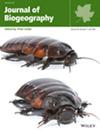Feeding Specialisation Shapes Avian Functional Diversity Along a Tropical Rainforest Elevational Gradient
Abstract
Aim
Avian functional diversity in montane systems has been scrutinised by researchers seeking to uncover deterministic processes driving community assembly. However, many tropical rainforests lack fully surveyed elevational gradients that could inform on functional ecology of avian assemblages. Here we expand global coverage of elevational trends in bird functional diversity to the third largest contiguous rainforest in the world.
Location
A 3500 m uninterrupted rainforest gradient in Papua New Guinea.
Taxon
Birds.
Methods
We conducted point-count surveys of bird communities, sampling eight elevational sites from 200 m above sea level to the treeline at 3700 m. Functional diversity indices (functional richness, evenness, and divergence) were examined using Bayesian generalised additive models after standardising for bird species richness. Additionally, we analysed phylogenetic diversity and structure, and examined variation in individual functional traits, including feeding guild, morphology, and dispersal ability.
Results
Functional richness declined sharply from the lowlands to 1700 m above sea level, followed by a weak decrease towards the treeline. Functional evenness decreased monotonically with elevation, while functional divergence increased at low elevations and again near the treeline. Phylogenetic diversity exhibited a monotonic decline accompanied by increased phylogenetic clustering at higher elevations. The mid-elevation collapse of functional richness was likely caused by trophic interactions. Reduced the availability of large fruits caused declines in frugivore body size and beak dimensions, while high abundance of invertebrates favoured functionally uniform insectivores. Near the treeline, bird communities displayed morphological shifts towards terrestrial lifestyles with reduced dispersal ability, suggesting environmental filtering by forest structure.
Main Conclusions
By examining trends in individual functional traits, we highlight the role of trophic interactions in shaping avian functional diversity in tropical montane systems. Similar research using robust trait data can deepen our understanding of ecosystem functions and guide conservation strategies for different functional groups of birds across tropical regions.

 求助内容:
求助内容: 应助结果提醒方式:
应助结果提醒方式:


